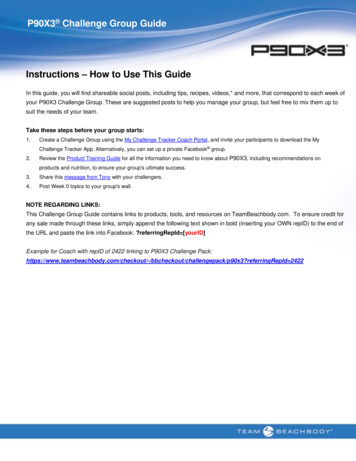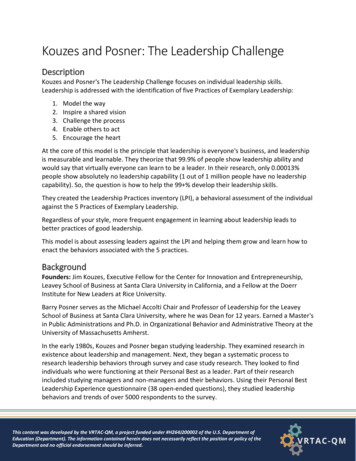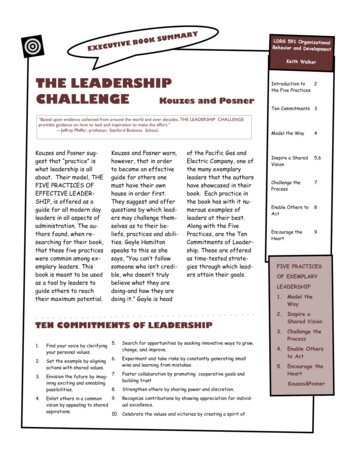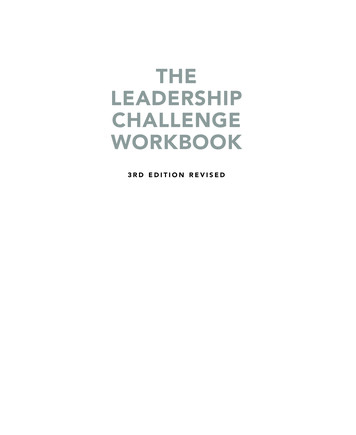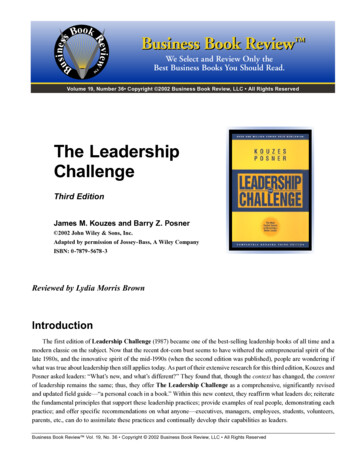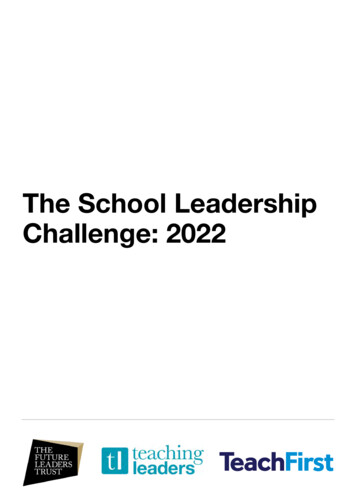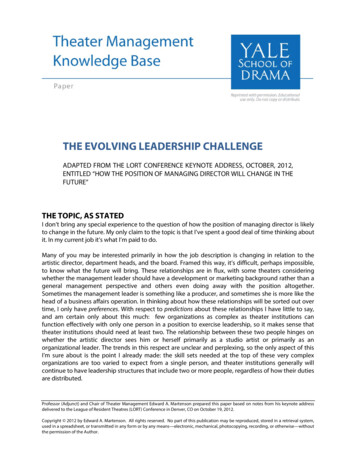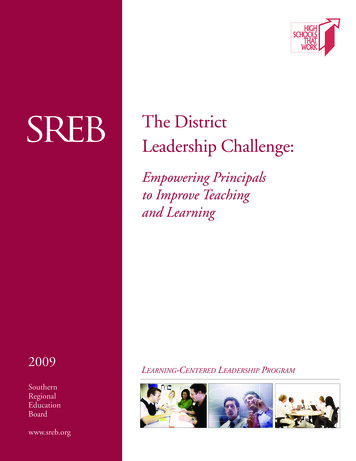
Transcription
The DistrictLeadership Challenge:Empowering Principalsto Improve Teachingand .orgLEARNING-CENTERED LEADERSHIP PROGRAM
This report was developed by Gene Bottoms, SREB senior vice president, and Betty Fry, director,Leadership Research and Publications.The research and the publication are supported by the Wallace Foundation, which seeks to support andshare effective ideas and practices that expand learning and enrichment opportunities for all people.The foundation’s three current objectives are to 1) strengthen education leadership to improve studentachievement; 2) improve out-of-school learning opportunities; and 3) expand participation in arts andculture. In pursuit of these goals, Wallace supports the development of knowledge and analysis frommultiple sources and differing perspectives. The findings and recommendations of individual reports aresolely those of the authors. For more information and research on these and other related topics, pleasevisit Wallace’s Knowledge Center at www.wallacefoundation.org.
Executive SummaryThe Principal SolutionNearly 7,000 students drop out of American high schools each day. Altogether, an estimated1.2 million teenagers abandon the public school system each year without a diploma or an adequateeducation. A disproportionate number will have attended the nation’s 2,000 high schools in which lessthan 60 percent of students graduate within four years of entering the ninth grade.The future is not much brighter for many of those students who do persist and earn a high schooldiploma. An estimated 40 percent of freshmen in community colleges (and 20 percent in public four-yearinstitutions)1 require remedial instruction in reading, writing or mathematics before they can succeed incollege-level courses.Unless high school conditions change dramatically, these same statistics will be repeated year afteryear. Since 2001, billions of public and private dollars have been invested in reforms designed to solve theproblems of the American high school, from small-school initiatives to high-stakes exit exams. Yet the mostrecent data reported by Education Week’s Diplomas Count project reveal that nearly 30 percent of the classof 2008 failed to graduate with their peers.What is missing from efforts to promote positive change? In SREB’s view, a central reason forthe unending graduation and preparation problems is the failure of many public school districts tosystematically provide the working conditions that well-trained principals need to succeed.Districts have to treat principals like they expect them to lead. Principals and teachers need controlover the learning process. District leaders need to invite innovation in every school and assist the innovatorsby marshalling their own leadership skills to engage communities in powerful conversations about the needfor change.What Principals Are SayingTo better define what is missing from districts’ support of principals’ working conditions, theSouthern Regional Education Board (SREB) surveyed principals about the conditions under whichdistricts currently expect them to improve school and student performance. This research, which wassupported by and grounded in SREB’s extensive school improvement experience, was designed to answerone key question: What perceptions do high school principals have of the conditions their districts are providingin support of school improvement?
The initial study included confidential interviews with 22 principals implementing the SREB HighSchools That Work (HSTW) school improvement model. These principals led schools in small, medium andlarge districts in 17 states. (See Appendix B for a complete description of the study.)SREB focused the interviews on seven strategies identified by research as commonly present in schooldistricts that effectively support school reform:1. Establish a clear focus and a strategic plan for improving student achievement.2. Organize and engage the district office in supporting each school to create and implement acustomized school improvement agenda within a district improvement framework.3. Provide instructional coherence by establishing a vision of effective instructional practice; aligningcurriculum, instruction and assessment to the vision and to state and national standards; andcreating the context for meaningful learning experiences.4. Invest heavily in instruction-related professional learning for principals and teachers that is alignedwith the district and school-specific improvement agendas.5. Provide high-quality data that link student achievement to school and classroom practices andassist schools to use data effectively.6. Optimize human, financial and other resources to provide a level of support that is sufficient forschools to produce specified student performance results.7. Use open, credible processes to involve progressive school and community leaders in schoolimprovement.By comparing the interview responses of principals in high-performing and low-performing schools,SREB learned more about how relationships between central office leaders and high school principals canmagnify or diminish the principal’s capacity to effectively lead a school to higher levels of achievement.Principals at the most-improved high schools felt they had a collaborative working relationship withthe district. They gave a much more expansive description of district staff responsibilities for improvingstudent achievement and the support they received from the district.In the least-improved high schools, most reform initiatives were centralized in the district office. Thedistrict was not concerned about empowering and building the capacity of school leaders to be real playersin school reform.These findings are consistent with SREB’s observations made over two decades of work to improvehigh schools and middle grades schools.ii
The Principal Must Be a PlayerCan high schools make significant gains in achievement, slash the dropout rate, and offer demandingand highly engaging instruction without the principal as a key player? A preponderance of recent researchsays they cannot.2Researchers have shown that a principal who is committed to school reform is crucial in sustainingschool improvement. Principals can profoundly influence student achievement by working with teachers toshape a school environment conducive to learning; aligning instruction with a standards-based curriculum;organizing resources to improve classroom instruction and student learning; and making good decisionsabout hiring, professional learning and other issues that influence the quality of teaching.Without such on-the-ground leaders, high schools stand little chance of helping more students meetgrade-level or higher standards, stay in school, and graduate prepared for the next steps in their educationand careers. Yet having such leaders in place is not enough. Even the most talented and best-trained principalswill fail if their working conditions do not support their improvement efforts.Principals’ working conditions are largely determined by leaders in the school district central office.And a recent National Academy of Sciences study concluded that purposeful district-level support of highschool reform is even more critical than that of elementary- or middle-level school reform.3High school principals need training, technical support, adequate resources and supportive policies tobecome instructional leaders who can focus more clearly on teaching, learning and the needs and interestsof students. They need encouragement and political support from their local school boards in order totake risks and implement innovative organizational structures, school schedules and partnerships withemployers and postsecondary institutions.High school principals who are striving to help students meet college- and career-readiness standardsneed a supportive work environment. They need the authority and political cover to meet the highdemands of the position, especially on curriculum, instructional methods and personnel. School districtsseeking to raise student achievement and high school graduation rates among all student groups mustensure that the entire range of conditions and incentives are in place for principals to help teachers improveteaching and learning.Depending on principals to be superheroes is not a solution to the problem of working conditions thathinder widespread high school reform. While some exceptional principals make progress despite the lack ofsupportive conditions, many others respond by foregoing attempts to make the complex changes in schooland classroom practices that can boost student motivation and achievement.iii
How District Leaders Can Power Up High SchoolsFind or develop the right principal for each high school. Expect principals to become instructionalleaders. Give them the authority and support to assume that role. Then hold them accountable.The most consistent research finding about school district effectiveness is this: Districts must maintaina strong focus on improving instruction and raising standards and achievement by supporting principals tobecome instructional leaders.By this standard, few school systems can claim to be near peak effectiveness. The challenge for districtsis two-fold: (1) Clear away regulations and conditions that hinder the ability of principals and teachersto improve curriculum, instruction and student achievement; and (2) build capacity within the district’scentral office to support school ownership of the learning process.Many districts are still more focused on educational management than educational leadership. Supportfor improving instruction is not grounded in research on effective teaching, nor does it set forth a systemicapproach to improvement that gives principals the guidance they need to bring about more effectiveinstructional practices.In districts with high-achieving high schools, principals have more time to concentrate oninstructional improvement. They have more resources and more flexibility in how they can use themto address the needs of students who have fallen behind in school. They are more likely to have effectivestudent counseling and instructional coaches in literacy and mathematics.In these districts, professional learning is built on promoting research-based school and classroompractices; aligning training with district and school priorities for improvement; and evaluating its impacton improving school and classroom practices and student outcomes.Expand the vision for teaching and learning in high schools beyond the minimums. Emphasizeinstruction that engages all students in authentic types of learning. Create the motivation forstudents to pursue a high school diploma.In too many districts, the district strategy is to circumvent principals on curriculum and instructionalmatters. The districts’ most common goals and expectations, as seen by principals, are related toimproving the state test scores of specific student groups and having a higher percentage of studentsmeet accountability targets as required by federal law. Too often, the district mission is for students to meetminimum standards — not accelerating achievement for all groups of students or producing high schoolgraduates who are well prepared for postsecondary education and careers.Districts failing to make major improvements in their high schools often do not have a cohesiveimprovement agenda — including clear goals, research-based practices, supporting strategies andimprovement-focused accountability. Instead, they are characterized by many incoherent actions.Principals experience these actions as fragmented or a series of random improvement acts, rather than awell-designed system of improvement.iv
Successful districts have a clear vision for improvement. They convey to principals an urgent need toexamine all aspects of the school — including scheduling, climate and culture, student motivation,instructional practices, use of resources, and partnerships with employers and postsecondary institutions— to identify and address the problems contributing to poor student performance. And they supportprincipals to accomplish this task.Give principals authority commensurate with their responsibility.A 2007 report commissioned by the Fordham Institute, The Autonomy Gap, notes “how little trueauthority principals enjoy in key areas. Their budgets are essentially handed down to them, or at leaststrictly regulated from above. In most cases, the curriculum is determined for their school, and they havelittle control over who works there.”4Many principals are involved neither in defining instructional issues that exist in their schools nor indeveloping viable solutions. Instead, these decisions are made at the district (or state) level. Principals havelittle ownership of problems and little support or motivation to find solutions.Regardless of district size, the principals of the most-improved schools in this study were more likelyto describe loose district control over decisions about school improvement (while principals of theleast-improved schools were more likely to describe tight district control).The principals who feel their authority is more commensurate with their responsibility reported thattheir superintendents and school boards support decentralized decision-making as much as possible —and especially support the principal’s ability to make personnel decisions and to recommend moving ordismissing teachers who do not meet expectations.In districts that decentralize decision-making, leadership roles have been redefined at all levels —from the superintendent, district office staff and school board, to principals and teachers. District staffmembers understand that their role is to support principals, not circumvent them. They visit schoolsfrequently to provide coaching, staff development and technical assistance. Principals in such districtshave the autonomy and resources to engage teachers continually in professional learning that targetsgroups and individual students, and teachers take leadership in working together to improve curriculumand instructional issues.Develop a collaborative partnership among the district, the principal and the school leadership staff.Rather than working with a supportive district, many principals spend time and effort finding ways towork around the district office to improve student achievement. They feel forced to circumvent protocolsfor hiring and develop underground relationships with individuals in the district office to find the supportthey need.The best districts demonstrate evidence of a collaborative “lattice” approach between the school andcentral office. With the right principals in place, districts are providing the necessary support for them tolead their schools to success. When districts allow principals to focus on school improvement, principalscan help their teachers to do the same.v
Give principals a full arsenal of strategies to meet the weighty expectations now being set forAmerica’s high schools.SREB’s research indicates that principals’ capacity to instigate improvements effectively is particularlylacking in high-needs schools. Principals often pointed out the failure of school districts to provideadequate staff support, technical assistance, professional learning, data analysis or resources to helpat-risk students.Successful districts provide school leaders with proven reform strategies such as new ways of usingschool time and organizing staff so teachers can work together on instructional issues, additional teachersand personnel with expertise in instruction, a range of extra-help strategies for students who needmore assistance and time to achieve proficiency, and an adequate supply of up-to-date instructional toolsand materials.Tailor support to the needs of individual schools.In many districts, some schools may perform well while others flounder. Districts need to set systemwide goals and then tailor their reform and support strategies to the unique characteristics of each school.In this study, principals in the most-improved schools were more likely to report frequent visits fromdistrict staff than were the principals in the least-improved schools. While meeting the needs of all schools,districts must provide the greatest amount of attention and assistance to schools in need of greatestimprovement. The goal is not to implement top-down control, but to build the capacity of each schoolleadership team to adapt and implement improvement strategies effectively.Principals of the most-improved schools were also more likely to describe visitors from the centraloffice as being focused on instructional matters than their counterparts in the least-improved schools.Anytime district staff visit a school, they bring a message about what is important. Their message shouldalways be about the why’s and how’s of accelerating student learning.Ensure principals have the necessary data and data-analysis skills to link information about resultsto students’ experiences in school.District improvement initiatives are spurred by the collection and analysis of data related to studentachievement. Effective districts provide and use data to guide district, school and classroom improvementsin instruction and student performance.Yet many districts hoard important performance data at the district level rather than helping principalsand teachers learn to use the data in improving curriculum and instruction. Often, if schools do get data,the primary focus is on fixing the students. The data seldom are used to reveal what could be fixed in thelearning system that allowed students to perform below grade level.Principals in the least-improved schools were far more likely to report that data were presented to themprimarily as evidence of their success (or, more often, failure) in reaching state-mandated performancetargets. This reveals a critical flaw in some districts’ understanding of how to use data to implementeffective improvement strategies.vi
One key use of data is to align resources in ways that address deficits. Effective districts provide awide range of data to schools to help them plan professional learning activities, to align curriculum andinstruction, to assist and evaluate personnel, and to identify students needing accelerated instruction toreach grade-level standards.Districts with effective improvement plans provide data to schools in ways that enable principalsand teachers to disaggregate and analyze the data by teacher, students’ gender, students’ ethnicity and othergroupings. These districts use data to identify specific strengths, weaknesses and achievement gaps betweengroups of students and help principals and teachers face challenges revealed by the data.Send a clear message to the community about the need for change.Districts must develop awareness among parents, business, and community leaders about howthey can support high schools in creating learning experiences that foster greater motivation among allgroups of students. Unfortunately, community involvement in schools often amounts to little more thaninformation sharing.Many districts fail to engage key stakeholders in understanding the larger vision of a modern highschool in the new competitive, global economy. They do not help principals develop partners — includingparent-leaders who can support the success of all students in the school — who will support change.Districts that build such community and parent partnerships begin by demonstrating theircommitment to a vision of high-performing schools and the research-based practices that will realizethat vision. They identify and acknowledge poor performance. They adopt an unwavering belief in thepotential of all students to meet high expectations. They take steps to help stakeholders understand that,to ensure more students finish a challenging core curriculum, schools will need to link their learningexperiences to authentic activities, problems and projects that expose them to the real work of careers.Principals as Leaders of ChangeThis report does not urge school districts to abandon their oversight of schools. Rather, district leadersmust support a comprehensive framework for school-level improvement and implementation. Centraloffice staff must reach agreement with principals about the improvement design and then expect schoolsto implement it. Districts should monitor implementation in action and define good implementation ofimprovement strategies.For many of the principals interviewed for this study, the work of high school improvement takes placemainly behind the closed doors of the school building. On the one hand, this condition allows principalsand teachers to take full ownership of problems and solutions. On the other hand, it deprives them of thesupport, technical assistance, coaching and collaboration they may need to transform that ownership intoimproved outcomes for all groups of students.The district leadership challenge is to move from oversight, from holding principals accountableat arms length, to providing the capacity-building support that true district-school partnershipsrequire. The research is clear and overwhelming: If school districts want high-achieving high schools, theymust empower principals to be leaders of change.vii
ContentsWhy Principals’ Working Conditions Matter . . . . . . . . . . . . . . . . . . . . . . . . . . . . . . . . . . . . . . . . . . .1Study Design and the Broader Context of Research Findings . . . . . . . . . . . . . . . . . . . . . . . . . . . .3Principals’ Concerns About Working Conditions: A Challenge for School Districts . . . . . . . . . . . . . .7How Can Districts Support Principals? . . . . . . . . . . . . . . . . . . . . . . . . . . . . . . . . . . . . . . . . . . .10Are District Strategies Providing Conditions That Support School Reform? . . . . . . . . . . . . . . . . . . .13Strategy 1. Establish a clear focus and a strategic plan for improving student achievement. . . . .13Strategy 2. Organize and engage the district office in support of each school. . . . . . . . . . . . . . . .20Strategy 3. Provide instructional coherence and support. . . . . . . . . . . . . . . . . . . . . . . . . . . . . . .25Strategy 4: Invest heavily in instruction-related professional learning for principals andschool leaders. . . . . . . . . . . . . . . . . . . . . . . . . . . . . . . . . . . . . . . . . . . . . . . . . . . . . . . . . . . . . . .32Strategy 5: Provide high-quality data that link student achievement to school andclassroom practices and assist schools to use data effectively. . . . . . . . . . . . . . . . . . . . . . . . . . . . .37Strategy 6: Optimize the use of resources to support learning improvement. . . . . . . . . . . . . . . .40Strategy 7: Use open, credible processes to involve progressive school and communityleaders in school improvement. . . . . . . . . . . . . . . . . . . . . . . . . . . . . . . . . . . . . . . . . . . . . . . . . .44In Closing: How States Can Support School Districts in Empowering Principals . . . . . . . . . . . . . . .47Appendix A: The High Schools That Work School Reform Framework . . . . . . . . . . . . . . . . . . . . . . . .51Appendix B: About the SREB Study of High School Principals’ Working Conditions . . . . . . . . . . .55Appendix C: Principal Interview Protocol . . . . . . . . . . . . . . . . . . . . . . . . . . . . . . . . . . . . . . . . . . . . .59Appendix D: Resources for an Evidence-Based Educational Approach in High Schools . . . . . . . . . .61Endnotes . . . . . . . . . . . . . . . . . . . . . . . . . . . . . . . . . . . . . . . . . . . . . . . . . . . . . . . . . . . . . . . . . . . . .63
Why Principals’ WorkingConditions MatterHigh schools’ capacity to improve studentachievement is an issue of mounting concern among federal,state and local policy-makers; educators; parents; and futureemployers. The problems of high dropout rates, low academicachievement, and large numbers of graduates who areunder-prepared to succeed in college and careers have ledmany critics to question the quality of education beingprovided by the nation’s high schools. Schools in high-povertyurban and rural areas are especially challenged by theseproblems.Research shows that, to improve student motivation andachievement, schools must pursue fundamental changes incurriculum, instructional practices, organizational structuresand school culture. Specifically, comprehensive reform mustresult in changes that engage students with relevant andintellectually challenging materials and must be based on thebelief that, with support, most students can achieve at highlevels.5 These reforms are complex, requiring dramaticchanges in traditional attitudes and beliefs about students’ability to master a rigorous academic curriculum, teachingmethods that foster students’ motivation to learn, andsupport needed by students and faculty to create apersonalized learning environment. Multiple approachesto reform are needed to achieve high expectations and highstandards for students’ learning.“Successful high school reformsconvey high expectations andpromote a sense of confidence ina student’s ability to succeed,feelings of control over academicoutcomes, beliefs in the value ofeducation, and a sense ofbelonging and respect. Effectiveschools and effective teachersprovide support and helpstudents understand what it takesto learn and succeed in school.”6Engaging Schools: Fostering High SchoolStudents’ Motivation to LearnMuch has been written about the changes schools need to make, and numerous reform efforts havebeen initiated by districts and schools; but the reality is that these fundamental changes have not occurredon a broad scale. While some high schools are posting gains in achievement across all groups of students,the nation’s overall record of progress leaves little doubt that most high schools have not made necessary,significant changes.
National Indicators Demonstrate the Need for Widespread High School Reform Less than one-third of rising freshmen read at grade level.7 More than 1.2 million high school students drop out every year — roughly 7,000 each day.8 More than 40 percent of freshmen in community colleges and 20 percent of freshmen in publicfour-year institutions require remedial instruction in reading, writing or mathematics to handlecollege-level work.9Less than 60 percent of students attending the 2,000 high-minority high schools across thenation graduate within four years of entering high school.10According to the National Association of Manufacturers, 60 percent of high school graduates arepoorly prepared for entry-level jobs.11The strategies that states and districts have relied on to drive school reform (e.g., higher standards,high-stakes testing, principal and staff accountability for meeting annual progress goals) are not enoughto get the job done. How do states, districts and schools ensure the complex changes crucial to thefuture of our students take place in every high school?Provide Schools With Effective PrincipalsPrincipals profoundly influence student achievementby working with teachers to shape a school environmentthat is conducive to learning; aligning instruction with astandards-based curriculum; organizing resources to improveclassroom instruction and student learning; and makingdecisions about hiring, professional learning and other issuesthat influence the quality of teaching.12 Schools need skillfuland knowledgeable leaders who work with all facultymembers to create an authentic and intellectually challengingcurriculum aligned with college- and career-readinessstandards and support teachers to use proven instructionalmethods. Without such leaders, there is little chance of theschool making the changes that will help more students meetat least grade-level standards, stay in school, and graduateprepared for the next steps in their education and careers.Provide Principals With Supportive WorkingConditions“A recent study of teachers’working conditions in NorthCarolina showed that effectiveleadership contributed to bothteacher retention and studentlearning. At the high schoollevel, high-quality leadershipwas the single greatestpredictor of whether or notschools had high studentachievement as definedby NCLB.”13Teacher Working Conditions AreOnce the right principals are in place, they must beStudent Learning Conditionsprovided with the support needed to lead their schools tosuccess. Even the best-trained principals will fail if theirworking conditions do not support improvement efforts or create insurmountable barriers tochange. A recent National Academy of Sciences study concluded that district support of high schoolreform is even more critical than that of elementary- or middle-level school reform.142
Principals’ and teachers’ working conditions are set in place through a host of state and districtpolicies and administrative rules. These policies set schools’ goals, strategies and program outcomes;allocate resources and funding; define professional learning and other services; and shape accountability.15Principals have to work within conditions set by state and local governance that either support or impedethem in leading successful schools — conditions that impact principals’ success encompass much morethan the readily obvious categories of school facilities, staffing and budgets. An article published by TheWallace Foundation described the conditions influencing principals’ work as follows:One way to think of these conditions of leadership is that they include anything affecting the success or failureof leaders that more training alone can’t fix. They include, among other things: the adequacy of resourcesincluding people, money and time; whether or not there is effective use of data to drive and evaluatedecision-making; the organizational culture; the panoply of incentives that either encourage or discourag
The challenge for districts is two-fold: (1) Clear away regulations and conditions that hinder the ability of principals and teachers to improve curriculum, instruction and student achievement; and (2) build capacity within the district’s . leadership team to adapt


